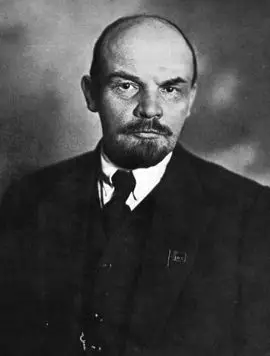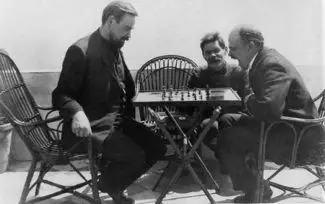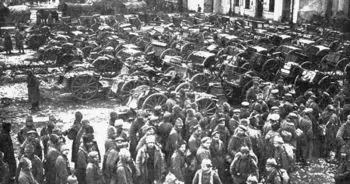Difference between revisions of "How did Vladimir Lenin Rise To Power"
| Line 27: | Line 27: | ||
Lenin proved decisive and ruthless from the very beginning. He neglected his fellow countrymen sufferings, because he was focused crushing any internal opposition or riots. The Red Army or as it was also commonly referred to - The Great Workers’ and Peasants’ Red Army - was raised by Lenin’s Bolsheviks to oppose the various military collectively known as the White army during the Russian Civil War. After 1922, the Red Army was transformed into the Army of the Union of Soviet Socialist Republics by the new regime. | Lenin proved decisive and ruthless from the very beginning. He neglected his fellow countrymen sufferings, because he was focused crushing any internal opposition or riots. The Red Army or as it was also commonly referred to - The Great Workers’ and Peasants’ Red Army - was raised by Lenin’s Bolsheviks to oppose the various military collectively known as the White army during the Russian Civil War. After 1922, the Red Army was transformed into the Army of the Union of Soviet Socialist Republics by the new regime. | ||
| − | ==Lenin’s Cult of Personality== | + | ====Lenin’s Cult of Personality==== |
| − | Lenin | + | Lenin was a powerful and gifted orator From early age Vladimir was capable of effectively communicating complicated concepts and ideas to the his audience. Lenin could effectively communicate with Russians who had limited education. Unfortunately, Lenin was more interested in building a country around his persona instead of trying to improve the lives of Russian citizens. Lenin was fairly ruthless with any opposition to his rule. Millions of free-will poets, philosophers or priests lost their lives or were forced to emigrate. The OrthodoxChurch was almost completely banned. |
| − | Lenin’s absolute authoritarian regime | + | Lenin’s absolute authoritarian regime generated opposition and he narrowly survived a few assassination attempts. In one of these attempts, Lenin was severely wounded and his long term health was affected. Lenin's injury and workaholic nature eroded his health. In May 1922 he suffered a stroke from which he never fully recovered. He lost his power of speech and his right arm and leg were paralyzed. In December, he had another stroke. The third followed in March 1923 and turned him into a living corpse. Lenin died on 24 January 1924. His corpse was embalmed and emblematically placed in a mausoleum in his memoriam on Moscow's Red Square. St Petersburg was renamed Leningrad in his honor. |
==Conclusion== | ==Conclusion== | ||
Revision as of 18:23, 13 April 2018
Vladimir Ilyich Ulyanov (later known as Lenin as he solely nicknamed himself) was one of the leading political figures in the course of the 20th century. He was the revolutionary thinker behind the USSR idea (a.k.a. The Great Soviet Union), fought to materialize it and masterminded the Bolshevik bloody takeover of power in Russia after World War One. Although Lenin's reign as the head of the newly created Soviet Union was extraordinarily his influence stretched throughout the 20th century.
Lenin’s Early Life
Vladimir Ilyich Ulyanov was born on 22 April 1870 in Simbirsk on the Volga River into a well-educated family. He excelled at school and chose to pursue a law studies and career. However, while he was at university his brother, Aleksandr Ulyanov, was involved with “Narodovoltsy” – a revolutionary terrorist society and in 1891 he was arrested and executed for taking part in an assassination plot against Tsar Alexander III. His brother's execution radicalized Vladimir. He turned his anger towards =the ruling Tsarist regime. His brother's execution along with his father’s death marked a turning point in his life and shaped his path in the future.
Soon after his brother execution, Lenin was expelled from the university for his active participation in student protests against Tsarist regime. He was forced to continue his law studies as an external student at St. Petersburg University. Around this time he also became passionately interested in Karl Marx’s works. He joined Marxists groups when he was 21 and in essence became a professional revolutionary. Lenin became involved with various Marxist societies and radical groups and published his writings on politics and Marxism.
Almost all of his writing were immediately banned and restricted by the Tsarist regime. The only way to get a hold of his writings was to passed them by hand from person to person. His writings quickly caught the eye of other Russian radicals and he was declared an “enemy of the state” by the Russian police. He was arrested by Tsarists police in St. Petersburg and imprisoned for a year for sedition. After his release, he was again arrested in 1897 for his radical views and ideas and sent to exile in Siberia for 3 years. Lenin and family were sent to Siberia where he lived in Shushenskoye. During his Siberian exile, Vladimir adopted the famous moniker “Lenin.” While in Siberia, Lenin wrote constantly with his wife, Nadezhda Krupskaya. His exile did little to damper his revolutionary zeal.
Lenin - the Young Revolutionary
Once Lenin was released, he continued to passionately work on his views regarding social imbalance and formed the Bolsheviks. The Bolsheviks would become the preeminent party of Russian Marxists shaped the future Communist Party.[1] The synthesis of Lenin’s views combined together with those of Karl Marx created what we now know as “Marxism-Leninism” or the basis of whole Communist doctrine throughout the 20th century.
His teachings attracted more and more passionate followers. Unsurprisingly, he writing unpopular with the Russian authorities. Vladimir argued in favor at total state ownership of all property, abolishing Tsarists privileges, equal rights for all and the elimination of unemployment. As the tension grew, Lenin decided to leave the country for security reasons and move to Western Europe. He spent there most of the subsequent 15 in self-imposed exile. After his move to Eastern Europe, he became a prominent member of the international revolutionary movement.
Away from Russia, he continued to publish and won more followers on his side. He created the published his newspaper “Iskra” (“Spark”) in Munich with the motto “From Spark to Flame!” Aided by foreign funds, Lenin actively challenged established the doctrine, policy and institution of the ruling Tsarist regimes.
World War I Fatigue
In 1917, exhausted by World War One, Tsarist Russia was a wreck. It was the perfect chaos moment for Lenin to return home. Germany, in effort to destabilize Russia, helped send Lenin back to Russia. They hoped Lenin would undermine the Russian war efforts. Instead of arrested and exiled again, Lenin was warmly welcomed home and supported by other radical thinkers such as Leon Trotsky. He quickly became the leader of the Marxist movement and led the Bolsheviks in the bloody violent Red October Revolution. Lenin, much to his own surprise, effectively ended the Russian Empire rather easily and established the Soviet state. The Tsar had become incredibly unpopular and were willing to embrace Lenin's revolution.
In the following three years of civil war, the Bolsheviks successfully assumed total control of the Russia. Lenin acted as the first head of this new socialistic regime and was the architect of the USSR itself. Lenin also commanded and led the famous Red Army - established immediately after the 1917 October Revolution. [2]
Lenin proved decisive and ruthless from the very beginning. He neglected his fellow countrymen sufferings, because he was focused crushing any internal opposition or riots. The Red Army or as it was also commonly referred to - The Great Workers’ and Peasants’ Red Army - was raised by Lenin’s Bolsheviks to oppose the various military collectively known as the White army during the Russian Civil War. After 1922, the Red Army was transformed into the Army of the Union of Soviet Socialist Republics by the new regime.
Lenin’s Cult of Personality
Lenin was a powerful and gifted orator From early age Vladimir was capable of effectively communicating complicated concepts and ideas to the his audience. Lenin could effectively communicate with Russians who had limited education. Unfortunately, Lenin was more interested in building a country around his persona instead of trying to improve the lives of Russian citizens. Lenin was fairly ruthless with any opposition to his rule. Millions of free-will poets, philosophers or priests lost their lives or were forced to emigrate. The OrthodoxChurch was almost completely banned.
Lenin’s absolute authoritarian regime generated opposition and he narrowly survived a few assassination attempts. In one of these attempts, Lenin was severely wounded and his long term health was affected. Lenin's injury and workaholic nature eroded his health. In May 1922 he suffered a stroke from which he never fully recovered. He lost his power of speech and his right arm and leg were paralyzed. In December, he had another stroke. The third followed in March 1923 and turned him into a living corpse. Lenin died on 24 January 1924. His corpse was embalmed and emblematically placed in a mausoleum in his memoriam on Moscow's Red Square. St Petersburg was renamed Leningrad in his honor.
Conclusion
If we measure greatness by the power of will and the scale of damage, then Lenin was truly by all means one of the most remarkable politicians. He destroyed one powerful empires to create another based on extreme violence. In many ways he defined the development of world history throughout the 20th century. Certainly, Lenin was the founder of the idea and the guiding spirit of the Soviet Republics for many decades that followed - a communist philosopher, disciple of Karl Marx, a leader of the Bolshevik (Communist) Party and the mastermind of the 1917 Red October Revolution.
Some may consider him a defender, others - a tyrant; some call him a saint, many more – a devil. But all in all Lenin played an enormous role in the history of the 20th century. He applied communist ideas to real life and his “experiment” forever changed the face of the world. Not only did he reshape all Russia but also had millions of people bent to his will, changing the very course of history in his own regard. Lenin was the first revolutionary dictator of the century with influence on a global scale. He was not the last and paved the way for Stalin, Hitler, Mao and many others that followed as his Marxism-Leninism ideas and works were refreshed and broadly adopted afterwards during the Cold War. Nonetheless, it took over 70 years and millions of lives to put an end to Lenin’s era and forced utopia.
Related DailyHistory.org Articles



